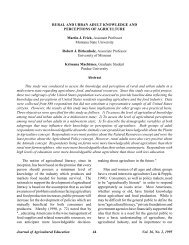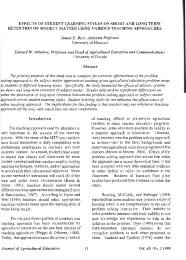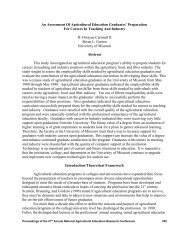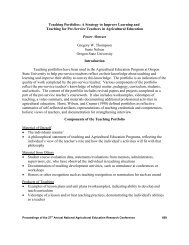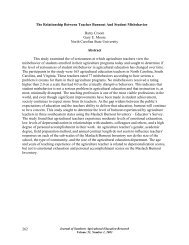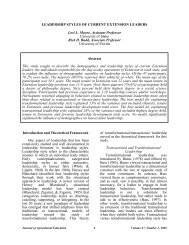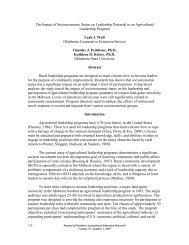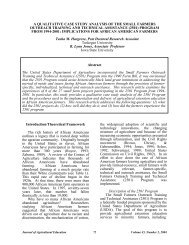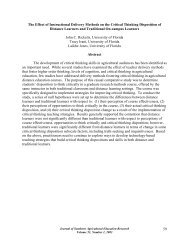Relationships Between Critical and Creative Thinking - Agricultural ...
Relationships Between Critical and Creative Thinking - Agricultural ...
Relationships Between Critical and Creative Thinking - Agricultural ...
You also want an ePaper? Increase the reach of your titles
YUMPU automatically turns print PDFs into web optimized ePapers that Google loves.
Paul (1995) further refined critical thinking by identifying three thought traits <strong>and</strong>/orprocesses possessed by the critical thinker. They are elements of reasoning, traits of reasoning,<strong>and</strong> reasoning st<strong>and</strong>ards.Elements of reasoning consist of seven components that help guide the reasoning process.These components include the purpose of the thinking or the question at h<strong>and</strong>, information<strong>and</strong>/or facts about the question, assumptions made about the question, interpretation of the facts<strong>and</strong> data collected, theories <strong>and</strong> concepts related to the question, <strong>and</strong> inclusion of other points ofview. Finally, an assessment of the conclusions is drawn with emphasis on implications <strong>and</strong>consequences of the decisions reached as a result of the thinking process (Figure 1).Conclusions/Implications/ConsequencesPoints ofViewConcepts/TheoriesInform ation/Facts/DataA ssum ptionsDataInterpretationFigure 1: Elements of ReasoningTraits of critical thinkers include independent thinking, intellectual empathy, intellectualhumility, courage, integrity, perseverance, intellectual curiosity, faith in reason, intellectualcivility, <strong>and</strong> intellectual responsibility. These traits are not only present in critical thinkers, theyare consciously utilized to guide the thinking process (Paul, 1995).Rudd, Baker, Hoover, <strong>and</strong> Gregg (1999) offered the following definition:<strong>Critical</strong> thinking is a reasoned, purposive, <strong>and</strong> introspective approach to solvingproblems or addressing questions, with incomplete evidence <strong>and</strong> information, <strong>and</strong>for which an incontrovertible solution is unlikely.<strong>Creative</strong> <strong>Thinking</strong>Creativity is a complex construct <strong>and</strong> is most commonly expressed through a broad rangeof intelligences including linguistic, musical, mathematical, spatial, kinesthetic, interpersonal,<strong>and</strong> perhaps even intrapersonal (Gardner, 1985). In a classic study of creativity, Taylor (1959)proposed the existence of five typologies for creativity. These were expressive, productive,inventive, innovative, <strong>and</strong> emergenative.Journal of Southern <strong>Agricultural</strong> Education Research 175Volume 51, Number 1, 2001
Expressive creativity is the type of spontaneous creativity often seen in children <strong>and</strong> isexemplified in drawings <strong>and</strong> play. Scientists <strong>and</strong> artists illustrate productive creativity. Anelement of spontaneous production remains, yet is characterized by the need to create ratherbeing restricted by the need to express. The third classification is inventive creativity that may bedescribed as a problem solving or a creation to improve an existing technology. An examplewould be an engine invented to make farm tractors more fuel-efficient. Innovative creativitydeals with the capacity to improve or reinvent an existing organism or object through theutilization of conceptualization skills. An example is the recent movement to reinventgovernment, in which the existing governmental structure was redefined throughreconceptualization. The final type of creative skill is emergenative. It is a new creation openingan entirely new paradigm. An example is the interventions of chemical fertilizers, insecticides,<strong>and</strong> hybrid seeds that helped to launch the Green Revolution. Emergenative creativity is adiscovery that opens an explosion of ideas in a synergetic fashion (Taylor, 1959).In an operationally problem-oriented definition, Torrance (1966) defined creativity as:A process of becoming sensitive to a problem, deficiencies, gaps in knowledge, missingelements, disharmonies, <strong>and</strong> so on; identifying the difficulty; searching for solutions,making guesses, or formulating hypothesis about these deficiencies; testing <strong>and</strong> retestingthese hypotheses <strong>and</strong> possibly modifying <strong>and</strong> retesting them; <strong>and</strong> finally communicatingthe results. (p. 6)Figure 2 presents forces <strong>and</strong> factors in the creative thinking process model. This model isone cycle that consists of three distinct phases: (1) an initial catalyst; (2) a gestation period; <strong>and</strong>(3) a problem solution <strong>and</strong> verification phase. In one’s reality, any problem experienced inhis/her livelihood system or expressive creative "seed" could serve as an initial catalyst (Wells,1984). After the initial catalyst, there is a gestation period where one begins to delineate theproblem that he/she wishes to solve. Finally there is a problem solution <strong>and</strong> verification processin which the individual comes up with a proposed resolution or creation which he or she thentests (Wells, 1984).Gestation Period(Problem Delineation, Incubation,Illumination)InitialCatalyst(Stimulusevent)Catalysts <strong>and</strong>InhibitorsInterpersonalVaiablesAttributes of CreativityCatalysts <strong>and</strong>InhibitorsCulturalVariablesProblemSolution <strong>and</strong>VerificationCatalysts <strong>and</strong> InhibitorsEducational VariablesCatalysts <strong>and</strong> InhibitorsFigure 2. <strong>Creative</strong>Biological Variables 1Process Cycle176 Journal of Southern <strong>Agricultural</strong> Education ResearchVolume 51, Number 1, 2001
The gestation phase includes four groups of often overlapping catalysts/inhibitors ofcreativity. These are encountered throughout life <strong>and</strong> either stimulate <strong>and</strong>/or limit one’s capacityto be creative. Wright (1987) listed the factors that influence a creative home environment as“respect for the child, the stimulation of independence <strong>and</strong> enriched learning environment" (p.34). Pratt-Summers (1989) found similar results to the one described above. Jausovoc (1988)<strong>and</strong> Dorner (1979) discovered that the teacher's teaching style (based on Piagtian cognitivetheory: exercise training, tactical training, <strong>and</strong> strategic training) was related to the developmentof creativity in students. These results support the notion that interpersonal variables areimportant catalysts <strong>and</strong>/or inhibitors of creativity.The second group of catalysts <strong>and</strong> inhibitors consists of biological variables such as age,genetics, health status, <strong>and</strong> gender (Krippner, 1991). The majority of the research has beenconcentrated on gender <strong>and</strong> birth order. There is not a consensus on the impact of gender uponcreativity. Torrance (1983) wrote, "a substantial body of evidence indicates that males <strong>and</strong>females perform at similar levels of tests designed to measure creative potential" (p. 134). Hefound that girls did not perceive themselves to be inventors <strong>and</strong> were largely influenced by theirenvironment. Harriss (1989) found that women were discouraged from becoming artists.Torrance <strong>and</strong> Allioti (1969) discovered that 13 year old girls had higher verbal creative abilitycompared to boys of the same age. Gupta (1979) did not find that there was a significantdifference between boys <strong>and</strong> girls in verbal creative ability, but found that there were distinctelements of non-verbal ability in which each scored significantly higher. The research on theimpact of birth order has detected that first-born males <strong>and</strong> females scored significantly higheron creativity tests than the second born (Comeau, 1980; Jaraial, 1985). The unique contributionof age, genetics, <strong>and</strong> health status to creativity is unclear.The third catalyst/inhibitor group is cultural variables. Krippner (1991) defined these associo-economic status, ethnic background, religious experience, <strong>and</strong> significant emotionalevents. There is a wealth of research to support the connection between socioeconomic status<strong>and</strong> creativity (Forman, 1979; Cicirelli, 1966; Singh, 1970; Kaltounis, 1974; <strong>and</strong> Torrance,1963). The exception to this was discovered by Warden <strong>and</strong> Pratt (1971) who found no divisionin creativity between any ethnic or social class.Cultural background was found to have an impact upon creativity of individuals fromJapan (Torrance <strong>and</strong> Sato, 1979), India (Sharma <strong>and</strong> Naruka, 1983; Torrance, 1981), the UnitedStates, Western Australia, Western Somoa, Germany, (Torrance, 1981) <strong>and</strong> the DominicanRepublic (Baker et al. 2000). Sharma <strong>and</strong> Naruka (1983) found a creative difference between theHindu, Muslim, <strong>and</strong> Christian religious groups in India.Torrance (1986) suggested the way that significant emotional events may affect creativeexpression when he wrote: "apparently, an intense emotional experience sets up a need forcreative expression <strong>and</strong> actually facilitates the creative expression" (p. 130).The final group of catalysts <strong>and</strong> inhibitors consists of personal attributes/educational factors.These include learning style, critical thinking, knowledge, motivation, creative response style,Journal of Southern <strong>Agricultural</strong> Education Research 177Volume 51, Number 1, 2001
<strong>and</strong> educational setting. Isaacs (1987) examined the importance of learning style <strong>and</strong> its impacton creativity when she stated:In some ways creativity is as delicate as the very breath of life. It can be nurtured <strong>and</strong>expended, or starved <strong>and</strong> diminished. Thus underst<strong>and</strong>ing <strong>and</strong> applying findings fromlearning style study is as important for sustaining creativity as for stimulating academicachievement. (p.257)Underst<strong>and</strong>ing the manner in which the individual learns facilitates academic achievement <strong>and</strong>can lead to an environment that enhances creativity.In discussing the impact of knowledge on creativity Sternberg <strong>and</strong> Luppart (1991) made thedistinction between knowledge <strong>and</strong> usable knowledge. They stated: “knowledge can be learnedin a way that makes it inert" (p. 610). Sternberg <strong>and</strong> Luppart (1991), when discussing theimportance of motivation, identified two key types: Intrinsic motivation <strong>and</strong> the motivation toexcel. Intrinsic motivation was seen as an important element because students are much morelikely to be creative if they enjoy what they are doing. Motivation to excel has been emphasizedbecause these individuals are willing to work for creative excellence.In the book The Nature of Creativity (1997) Torrance reviewed experiments that examinedthe effects of educational setting upon creativity. The majority of the research (Boersman <strong>and</strong>O’Bryan , 1968; Moham, 1970; Hooper <strong>and</strong> Powell, 1971; Nash, 1971; Ward, 1969; Norton ,1971; Khatena, 1971; <strong>and</strong> Kogan <strong>and</strong> Morgan, 1969) found that there was a difference increativity when the school environment (testing conditions, cue rich <strong>and</strong> cue poor, etc.) wasmanipulated. These findings were in contrast to studies by Alliotti (1969) <strong>and</strong> Towell (1972)who did not find any differences in creativity based upon changes in educational environments.The core of the gestation phase of the creative process model is the creative attributesreferred to by Torrance et al. (1990) as creative thinking abilities. These creative attributes werefluency, flexibility, originality, elaboration, abstractness of the title, resistance to closure,emotional expressiveness, articulateness, movement or action, expressiveness, synthesis orcombination, unusual visualization, internal visualization, extending or breaking the boundaries,humor, richness of imagery, colorfulness of imagery, <strong>and</strong> fantasy. The Torrance Test of <strong>Creative</strong><strong>Thinking</strong> (TTCT) is an instrument that can be used to operationalize these creative attributes.This process may or may not be linear. Each iteration is different in time <strong>and</strong> shape,depending on its interaction with the other catalysts <strong>and</strong> inhibitors described in the model. It iseven possible that a full iteration may not be completed because of factors such as motivation.The final phase of this model results in an end product <strong>and</strong> verification of creativity that isexpressive in problem solution <strong>and</strong> verification for the typologies (of creativity) proposed byTaylor (1958). However it is important to point out that there is a very important time dimensionto creativity. The time dimension is influenced by the perceived importance of the problem, aswell as the motivation, support, <strong>and</strong> resources available for problem resolution.178 Journal of Southern <strong>Agricultural</strong> Education ResearchVolume 51, Number 1, 2001
PurposeThe purpose of this study was to explore the relationships between creative thinking abilities<strong>and</strong> critical thinking disposition. The specific objectives of the study were: (1) to describe thestudents in terms of academic classification, creative thinking abilities, <strong>and</strong> critical thinkingdisposition; (2) to determine the amount of variance in creative thinking ability explained bycritical thinking disposition; <strong>and</strong> to (3) determine the relationship between creative thinkingability <strong>and</strong> gender.MethodologyA purposive sample consisting of students in a senior level project planning <strong>and</strong>evaluation course (n=32) <strong>and</strong> two instructional methods courses (n=4) <strong>and</strong> (n=14). Data werecollected spring, summer, <strong>and</strong> fall semesters of 1999.The researchers utilized two instruments for data collection. First, the Torrance Test for<strong>Creative</strong> <strong>Thinking</strong> – Form A (TTCT) was utilized to measure creative attributes. For this threeparttimed test, subjects are asked to construct a picture, complete a series of incompletedrawings, <strong>and</strong> complete drawings from sets of parallel lines. According to Torrance et al., 1990:The term "creative thinking abilities" as used in the TTCT, refers to that constellation ofgeneralized mental abilities that is commonly presumed to be brought into play increative achievements. . . The author has maintained that high degrees of the abilitiesmeasured by tests such as the TTCT increase the chances that the possessor will behavecreatively. Certainly, the author of these tests would never argue that possession of theseabilities guarantees that an individual will behave creatively, any more than a high degreeof intelligence guarantees intelligent behavior. . . <strong>Creative</strong> motivations <strong>and</strong> skills, as wellas abilities, are necessary for adult creative achievement." (p. 1)The TTCT results in quantitative scores for the following norm-referenced constructs: (1)fluency – the ability to produce a large number of figural images; (2) originality – unusualness orrarity of response; (3) abstractness – the ability to produce good titles <strong>and</strong> to capture the essenceof information involved; (4) elaboration – ability to develop, embroider, embellish, carry out, orotherwise elaborate ideas; <strong>and</strong> (5) resistance to premature closure – the ability to keep a figureopen <strong>and</strong> delay closure long enough to make the mental leap that makes original ideas possible.Content <strong>and</strong> construct validity has been established by the TTCT developer (Torrance et al.,1990). Intra-rater reliability coefficients are above the .90 level (Torrance et al., 1990). Inaddition to the TTCT, the researchers recorded the subjects’ academic rank <strong>and</strong> gender.The California <strong>Critical</strong> <strong>Thinking</strong> Disposition Inventory (CCTDI) was the secondinstrument utilized. The test consists of 75 Likert-type questions that represent 7 criticalthinking constructs (see Table 1). Content <strong>and</strong> construct validity has been established by CCTDIdevelopers (Facione, Facione, & Giancarlo, 1996). The developers report an overall reliability(Cronbach's α) of .90 <strong>and</strong> scale reliability scored from .72 - .80. Total scores range form 75-450.Journal of Southern <strong>Agricultural</strong> Education Research 179Volume 51, Number 1, 2001
The following descriptions of the CCTDI constructs are from the CCTDI test manual(Facione, Facione, & Giancarlo, 1996).Analyticity is a construct consisting of 11 items from the CCTDI. This construct targetsthe disposition of being alert to potentially problematic situations, anticipating possible results orconsequences, <strong>and</strong> prizing the application of reason <strong>and</strong> the use of evidence even if the problemat h<strong>and</strong> turns out to be challenging or difficult. The analytically inclined person is alert topotential difficulties, either conceptual or behavior, <strong>and</strong> consistently looks to anticipatoryintervention, reason giving, <strong>and</strong> fact-finding as effective ways to resolve matters.Self-confidence is a construct consisting of 9 items from the CCTDI. This construct refersto the level of trust one places in one’s own reasoning process. <strong>Critical</strong>ly thinking, self-confidentpersons trust themselves to make good judgments <strong>and</strong> believe that others trust them as well,since they believe that others look to them to resolve problems, decide what to do, <strong>and</strong> bringreasonable closure to inquiry.Inquisitiveness is a construct consisting of 10 items from the CCTDI. The inquisitiveperson is one who values being well informed, wants to know how things work, <strong>and</strong> valueslearning even if the immediate payoff is not directly evident.Maturity is a construct consisting of 10 items from the CCTDI. The maturity scaleaddresses cognitive maturity <strong>and</strong> epistemic development. CCTDI scoring gives preference tothose disposed to approach problems, inquiry, <strong>and</strong> decision making with a sense that someproblems are ill-structured, some situations admit of more than one plausible option, <strong>and</strong> manytimes judgments based on st<strong>and</strong>ards, contexts, <strong>and</strong> evidence which precludes certainty must bemade.Open-mindedness is a construct consisting of 12 items from the CCTDI. This constructtargets the disposition of being open-minded <strong>and</strong> tolerant of divergent views with sensitivity tothe possibility of one’s own bias. The open-minded person respects the rights of others toholding differing opinions.Systematicity is a construct consisting of 11 items from the CCTDI, targeting thedisposition to being organized, orderly, focused, <strong>and</strong> diligent in inquiry. No particular kind oforganization, e.g. linear or nonlinear, is given priority on the CCTDI. The systematic personstrives to approach specific issues, questions or problems in an orderly, focused, <strong>and</strong> diligentway, however that might be accomplished.Truth-seeking is a construct consisting of 12 items from the CCTDI, representative ofthose eager to seek the truth, who are courageous about asking questions, <strong>and</strong> honest <strong>and</strong>objective about pursuing inquiry even if the findings do not support one’s interests or one’spreconceived opinions. The truth-seeker would rather pursue the truth than win the argument.Total Score is a measure consisting of the 75 items from the CCTDI.180 Journal of Southern <strong>Agricultural</strong> Education ResearchVolume 51, Number 1, 2001
The CCTDI is used extensively in military science, law enforcement, allied health,engineering, <strong>and</strong> business. Although the researchers did not find evidence of CCTDI use inagriculture, the instrument was deemed appropriate for the purpose of identifying agriculturestudent's disposition to think critically (Facione, Facione, & Giancarlo, 1996).The data were analyzed by using SPSS/7.5 for Windows software. Descriptive statistics,multiple linear regression <strong>and</strong> point biserial correlational analysis was used to summarize <strong>and</strong>analyze the data.ResultsObjective number one was to describe the students in terms of academic classification,creative thinking abilities, <strong>and</strong> critical thinking disposition. Sixty-two percent of the students inthe sample were female, <strong>and</strong> 74% were classified as a senior. Approximately 12% of thestudents were juniors, <strong>and</strong> ten percent were classified as post-baccalaureate students.In terms of creative thinking ability, TTCT percentile scores were calculated from theraw scores based upon the adult population in the U.S. The students ranked in the 58 th percentilein fluency; 75 th percentile in abstractness; 51 st percentile in originality; 46 th percentile inelaboration; <strong>and</strong> 64 th percentile in their resistance to premature closure.Clearly the percentile scores reflect an average ability in fluency, originality, elaboration,<strong>and</strong> resistance to premature closure. The students had a greater ability to produce good titles <strong>and</strong>to capture the essence of information involved when compared to the general adult population.In terms of the critical thinking disposition, the CCTDI consists of seven sub-scales orconstructs <strong>and</strong> an overall CCTDI Total Score. The recommended cut score for each scale orconstruct is 40 <strong>and</strong> the suggested target score is 50. All scores range up to 60. Persons who scorebelow 40 on a given scale are weak in that critical thinking dispositional aspect, persons whoscore above 50 on a scale are strong in that dispositional aspect. In recording a 50, a person isdemonstrating consistent strength in that dispositional aspect. Inversely, scoring below 40indicates that, on average, the person responds in opposition to the critical thinking dispositionalaspect measured by a given scale.On six of the seven subscales, students in this sample could not be described as beingparticularly strong or weak (Open-mindedness - M=44.88, SD=5.39; Inquisitiveness - M=45.64,SD=6.28; Systematicity - M=42.33, SD=5.71; Maturity - M=45.92, SD= 6.41; Self-confidence -M=43.26, SD=5.73; Analyticity - M=44.13, SD=5.48). On the construct of Truth-seeking, theycould be described as slightly weak (M=39.10, SD=7.01).Just as scores of less than 40 shows weakness, an overall CCTDI score of less than 280shows serious overall deficiency in the disposition toward critical thinking. An overall score of350 or more is a solid indication of across the board strength in the disposition toward criticalthinking. However, an overall score of 350 is rare. People tend to have both strengths <strong>and</strong>weaknesses. The overall CCTDI score for this sample was 305.25 (SD=27.91).Journal of Southern <strong>Agricultural</strong> Education Research 181Volume 51, Number 1, 2001
The second research objective was to determine the amount of variance in creativethinking ability explained by critical thinking disposition. Five multiple linear regressionanalyses were utilized, with raw TTCT scores as the dependent variable, <strong>and</strong> CCTDI subscalesas the independent variables. Although none of the analyses were statistically significant, criticalthinking disposition accounted for 24% of the variance in resistance to premature closure(F=1.96, p=.08), 5% of the variance on fluency (F=.35, p=.93), 8% of the variance onabstractness (F=.55, p=.78); 2% on originality (F=.49, p=.83); <strong>and</strong> 1% on elaboration (F=.06,p=.99).The final research objective was to examine the relationships between creative thinkingability <strong>and</strong> gender. Low to negligible (Davis, 1971) bivariate relationships were found betweengender <strong>and</strong> resistance to premature closure (r=.07), fluency (r=-.03), abstractness (r=.24),originality (r=-.11), <strong>and</strong> elaboration (r=.15).Conclusion <strong>and</strong> ImplicationsIt appears that the collegiate educational experience has had little effect upon the students’ability to be creative or their disposition to think critically. Teaching students to rememberfactual information <strong>and</strong> return it in the form of an examination is the prevalent teaching modeemployed in secondary <strong>and</strong> post-secondary institutions today. Teaching thinking skills is adifficult <strong>and</strong> much different endeavor. Teaching to promote thinking takes more time to prepare,is difficult to plan, <strong>and</strong> limits the amount of content “taught.” Teachers can no longer beinformation givers. Students must learn thinking <strong>and</strong> reasoning skills to reach their fullestpotential in today's society (Meyers, 1986).The “more information is better” attitude unfortunately prevails in modern education. Thisis unfortunate considering that often the factual matter has a relatively short life span withstudents (Terezini, Springer, Pascarella, & Nora, 1993). When coupled with the fact thatinformation learned today quickly becomes outdated, is it any wonder that our students strugglewhen they reach the work place? Good thinking skills will not develop on their own, they mustbe taught (Beyer, 1987). Teaching students to think must be a priority of our schools today. Inany thought process we engage in both critical <strong>and</strong> creative thinking (Beyer, 1987).The term critical thinking is common in educational, psychological, <strong>and</strong> philosophicalcircles today. Employers, parents, administrators, <strong>and</strong> students themselves want critical thinkingskills developed in today's graduate. Developing critical thinking skills is not a new idea.Osborne (1932, p.402) stated that, "…it is assumed that development of thought power is one ofthe major aims of education." Dressel <strong>and</strong> Mayhew (1954) believed that educational institutionswere responsible for teaching students to go beyond the simple mental activities of recall <strong>and</strong>restatement of ideas <strong>and</strong> facts to the higher-level skills <strong>and</strong> habits involved in critical thinking.182 Journal of Southern <strong>Agricultural</strong> Education ResearchVolume 51, Number 1, 2001
Anderson (1990) explored the importance of creativity in higher education when hewrote:The college experience should include an opportunity to discover one’s potential <strong>and</strong>achieve higher levels of creative expression. The extent to which this happens depends oncurriculum <strong>and</strong> the commitment of the faculty members to nurture this development both inside<strong>and</strong> outside of the classroom. The learning environment as reflected by the classroom <strong>and</strong>campus setting, supportive extra-curricular <strong>and</strong> the advisor/student relationship all impact thetotal educational mission of developing creativity. (p. 55)Sutton <strong>and</strong> de Oliveira (1995) asserted that although students complete basic courses theyhave only a superficial underst<strong>and</strong>ing of what they have learned. In fact, few students are taughtthe skills needed to examine principles, values <strong>and</strong> facts.This study was limited to the groups that participated. The results from this study suggestthat the two constructs (critical <strong>and</strong> creative thinking) are not closely connected. Theseresearchers emphasize that much more research needs to be conducted with different age ranges,gender, <strong>and</strong> socio-economic background to confirm the results of this study. This researchshould help to answer very important questions on how to enhance the capacity of students tocritically <strong>and</strong> creatively think. The preliminary findings in this study suggest that educators mustprepare specific curriculum that stimulates creative <strong>and</strong> critical thinking separately.Journal of Southern <strong>Agricultural</strong> Education Research 183Volume 51, Number 1, 2001
ReferencesAlliotti. N. C. (1969). The effects of warm-up activities on the verbal creative thinking abilitiesof disadvantaged first grade children. (Doctoral Dissertaton, University of Georgia,1969). Dissertation Abstracts, 30 5275-A.Anderson, G. A. (1990). Teaching creativity for professional growth <strong>and</strong> personal reward.NACTA Journal, 34 (4), 54-55.Baker, M., Rudd, R.D., & Pomeroy, C. S. (2000). Creativity of Low Resource Farmers in theDominican Republic. Proceedings of the Association for International <strong>Agricultural</strong> <strong>and</strong>Extension Education’s Annual Conference, Arlington, Virginia.Beyer, B.K. (1987). Practical strategies for the teaching of thinking. Boston MA: Allyn <strong>and</strong>Bacon, Inc.Boersman, F. J. & O’Bryan, K. (1968). An investigation of the relationship between creativity<strong>and</strong> intelligence under two conditions of testing. Journal of Personality, 36 (3), 341-348.Burden, P.R., & Byrd, D.M. (1994). Methods for effective teaching. Boston, MA: Allyn <strong>and</strong>Bacon, IncCicirelli V. G. (1966). Religious affiliation, socioeconomic status <strong>and</strong> creativity. Journal ofExperimental Education, 35, (1), 90-93.Comeau, H. (1980). The relationship between sex, birth order, <strong>and</strong> creativity. Journal of<strong>Creative</strong> Behavior, 14 (1): 71.Crane, L.D. (1983). Unlocking the brain’s two powerful learning systems. Human IntelligenceNewsletter, 4, (4), 7.Davis, J. (1971). Elementary survey analysis. Englewood Cliffs, NJ: Prentice Hall.Dorner, D. (1979). Problem solving while processing information. Kolhamme, Meinz.Ennis, R. H. (1991). <strong>Critical</strong> thinking: A streamlined conception. Teaching Philosophy, 14 (1),5-24.Facione, P.A., Facione, C.F., & Giancarlo, C.A. (1996). The California critical thinkingdisposition inventory test manual. Millbrae, CA: California Academic Press.Forman, G. (1979). Effects of socio-economic status on creativity in elementary school children.The <strong>Creative</strong> Child <strong>and</strong> Adult Quarterly, 4 (2), 87-92.Gardner, H. (1985). Frames of mind: The theory of multiple intelligences. New York: BasicBooks.184 Journal of Southern <strong>Agricultural</strong> Education ResearchVolume 51, Number 1, 2001
Gupta, A. K. (1979). Sex difference in creativity. Journal of <strong>Creative</strong> Behavior, 13 (4): 269.Haley G. L. 1983. <strong>Creative</strong> response styles: The effects of socioeconomic status <strong>and</strong> problemsolvingtraining. Journal of <strong>Creative</strong> Behavior, 18 (1), 25-39.Halpern, D.F. (1996). Thought <strong>and</strong> knowledge: An introduction to critical thinking. Mahwah,NJ: Lawrence Erlbaum Associates, Publishers.Harriss, L. J. (1989). Two sexes <strong>and</strong> one mind: Perceptual <strong>and</strong> creative differences betweenwomen <strong>and</strong> men. Journal of <strong>Creative</strong> Behavior, 23 (1), 14-25.Hooper, P. P., & Powell, E. R. (1971). Influence of musical variables on pictorial connotations.Journal of Psychology, 76 (1), 125-128.Isaacs, A. F. (1987). Creativity <strong>and</strong> learning styles how achievement can be limited orfacilitated. The <strong>Creative</strong> Child <strong>and</strong> Adult Quarterly, 7 (4), 249-257.Jaraial, G. S. (1985). Creativity <strong>and</strong> birth order. Journal of <strong>Creative</strong> Behavior, 19 (2): 139.Jausovoc, N. (1988). Enhancing creativity in curricular areas at the elementary level. The<strong>Creative</strong> Child <strong>and</strong> Adult Quarterly, 14 (3), 142-150.Kaltounis, B. (1974). Socioeconomic status <strong>and</strong> creativity. Psychological Reports, 35 (1), 164-166.Khatena, J. (1971). Adolescents <strong>and</strong> the meeting of deadlines in the production of original verbalimages. Gifted Child Quarterly, 15 (3), 201-204.Kogan, N. & Morgan, F. T. (1969). Task <strong>and</strong> motivational influences on the assessment ofcreative <strong>and</strong> intellective ability in children. Genetic Psychology Monograph, 80, 91-127.Krippner, S. (1991). The social construction of creative children. The <strong>Creative</strong> Child <strong>and</strong> AdultQuarterly, 16 (4), 238-244.Meyers, C. (1986). Teaching students to think critically. San Francisco, CA. Jossey-Bass Inc.Publishers.Moore, B.N. & Parker, R. (1994). <strong>Critical</strong> <strong>Thinking</strong>. Mountain View. CA: Mayfield.Moham, M. (1970). Interaction of physical environment with creativity <strong>and</strong> intelligence.Unpublished Doctoral Dissertation, University of Alberta, Alberta.Journal of Southern <strong>Agricultural</strong> Education Research 185Volume 51, Number 1, 2001
Nash, N. R. (1971). Effects of warm- up activities on the creative thinking of disadvantaged firstgrade children. Unpublished Doctoral Dissertation, University of Georgia, Athens,Georgia.Norton, W. A. (1971). Effects of loudness <strong>and</strong> type of music on figural creativity, reading, <strong>and</strong>arithmetic computation tasks. Unpublished Doctoral Dissertation, University of Georgia,Athens, Georgia.Osborne, W.J. (1932). Testing <strong>Thinking</strong>. Journal of Educational Research, 27 (1), 402.Paul, R. W. (1995). <strong>Critical</strong> thinking: How to prepare students for a rapidly changing world.Santa Rosa, CA: Foundation for <strong>Critical</strong> <strong>Thinking</strong>.Pascarella, E., & Terenzini, P. (1991). How college affects students: Findings <strong>and</strong> insights fromtwenty years of research. San Francisco, CA: Jossey Bass.Pratt-Summers, P. (1989). The emergence of creative personality: the synergism of effectiveparenting. The <strong>Creative</strong> Child <strong>and</strong> Adult Quarterly, 14 (3), 136-146.Rudd, R.D., Baker, M.T., Hoover, T.S., & Gregg, A. (1999). Learning styles <strong>and</strong> criticalthinking abilities of College of Agriculture students at the University of Florida.Proceedings of the 49 th Annual Southern Region <strong>Agricultural</strong> Education ResearchMeeting. Memphis TN. 123-134.Scriven, M. (1976). Reasoning. New York: McGraw-Hill.Sharma, K. N. & Naruka, N. (1983). The effect of religio-culturism upon flexible productions.The <strong>Creative</strong> Child <strong>and</strong> Adult Quarterly 8, (3), 168-174.Simon, H.A., & Kaplan, C.A. (1989). In M.I. Posner (Ed), Foundations of cognitive sciences (pp.1-47). Cambridge, MA: MIT Press.Singh, S. P. (1970). <strong>Creative</strong> abilities: a cross-cultural expression. Journal of SocialPsychology, 81, (2), 126-126.Stall, N.N., & Stahl, R.J. (1991). We can agree after all: Achieving a consensus for a criticalthinking component of a gifted program using the Delphi technique. Roeper Review, 14(2), 79-88.Sternberg, R. J. & Luppart, T.I. (1991). Creating creative minds. Phi Delta Kappan, 71 (1), 608-614.186 Journal of Southern <strong>Agricultural</strong> Education ResearchVolume 51, Number 1, 2001
Sutton, J.P., de Oliveira, P.C. (1995). Differences in critical thinking skills among studentseducated in public schools, Christian schools, <strong>and</strong> home schools. ERIC Document No.ED 390-147.Taylor, I. A. (1959). The nature of the creative process. In P. Smith (ed.) Creativity (pp. 51-82).New York, NY: Hasting House.Torrance, E. P. (1963). Education <strong>and</strong> the creative potential. Minneapolis, MN: University ofMinnesota Press.Torrance, E. P. (1966). Rationale of the Torrance tests of creative thinking ability. In Torrance,E. P. <strong>and</strong> W. F. White (eds.). 1969. Issues <strong>and</strong> advances in education psychology. Istica,IL: F. E. Peacock.Torrance, E. P. (1981). Cross-cultural studies of creative development in seven selectedsocieties. In J.C. Gowan, J. Khatena, <strong>and</strong> E. P. Torrance (eds.). Creativity: Itseducational implications. Toronto, Ontario: Kendall Hunt Publishing Company.Torrance, E. P. (1983). Status of creative women: Past, present, <strong>and</strong> future. The <strong>Creative</strong> Child<strong>and</strong> Adult Quarterly, 8 (3), 135-145.Torrance, E. P. (1986). Intense emotional experiences- impetus to creation. The <strong>Creative</strong> Child<strong>and</strong> Adult Quarterly, 6 (3), 130-137.Torrance, E. P. (1997). The nature of creativity as manifest in its testing. In R.J Sternberg (ed.)The Nature of Creativity (pp. 43-75). Cambridge, UK: Cambridge University Press.Torrance, E. P. & Allioti N. C. (1969). Sex differences in levels of performance <strong>and</strong> test-retestreliability on the Torrance tests of creative thinking ability. Journal of <strong>Creative</strong> Behavior,3 (1), 52-57.Torrance, E. P., E. B. Orlow, & Safter H. T. (1990). Torrance tests of creative thinking.Bensenville, IL: Scholastic Testing Service.Torrance, E. P. & Sato. S. (1979). Differences in Japan <strong>and</strong> the United States styles of thinking.The <strong>Creative</strong> Child <strong>and</strong> Adult Quarterly, 4 (3), 145-151.Towell, R. D. (1972). Performance of high <strong>and</strong> low curiosity subjects on timed <strong>and</strong> untimedtests of creativity. Unpublished Doctoral Dissertation, University of Georgia, Athens,Georgia.Ward W. D. (1969). Creativity in young men. Child Development, 39 (3), 737-754.Warden, P. G. & Pratt, R. S. (1971). Convergent <strong>and</strong> divergent thinking in black <strong>and</strong> whitechildren of high <strong>and</strong> low socioeconomic status. Psychological Reports, 36 (3), 715-718.Journal of Southern <strong>Agricultural</strong> Education Research 187Volume 51, Number 1, 2001
Wells, D. (1984). Catalysts of creativity. The <strong>Creative</strong> Child <strong>and</strong> Adult Quarterly, 9 (3), 143-148.Wright, C. (1987). Nurturing creative potential: An interactive model for home <strong>and</strong> school. The<strong>Creative</strong> Child <strong>and</strong> Adult Quarterly, 7 (1), 31-38.188 Journal of Southern <strong>Agricultural</strong> Education ResearchVolume 51, Number 1, 2001




